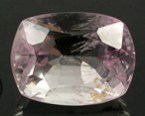Poudretteite Info
Back to Poudretteite
Poudretteite is a member of the osumilite/milarite group of minerals*. Although its Mohs hardness is only 5, clear resp. facetable crystals or even faceted gems are very sought after because of their rarity. Poudretteite is only found at two locations in Canada and Myanmar.
*Armenite, Brannockite, Chayesite, Darapiosite, Dusmatovite, Eifelite, Emeleusite, Merrihueite, Milarite, Osumilite, Osumilite-(Mg), Poudretteite, Rödderite, Sogdianite, Sugilite and Yagiite.
History
Seven poudretteite crystals were first discovered in the Poudrette Quarry / Mont St. Hilaire / Québec / Canada, around 1965. They were colorless to very pale pink, etched, barrel-shaped hexagonal prisms with a maximum length of 0.5 cm, associated with pectolite, apophyllite and aegirine. Until 1986, these only poudretteite crystals were not recognized as a new mineral species.
 |
| The 9.41 ct Stone * |
In 2004, ten other examples of poudretteite were identified amoung Mogok stones, the largest being a 22 ct crystal that was cut into a 9.41 ct gem. Until mid-2007, about only 30 small pieces of rough poudretteite have been unearthed in Mogok.
* Photo by kind permission of © www.aigsthailand.com/, Dr. Laurent Massi.
Color and Quality
The color of poudretteite varies from colorless to a saturated purple-pink, partially depending on its strong pleochroism: intense purple-pink parallel to the C axis, and nearly colorless to light brown vertical to it.
Manganese is the main chromatophore (color giving element) in poudretteite. The more Mn in the crystal structure, the more intense purple-pink saturation. Colored stones are more valuable than colorless ones although all poudretteites are very expensive.
Poudretteites can be eye-clean to heavily included. The less inclusions the more valuable. Clean gems over 1 ct are rare. Well-colored, clean stones are most expensive. The carat price can reach USD 6,000 or more.
⇐ Intro Page ⇐ Gemstones ⇐ Poudretteite